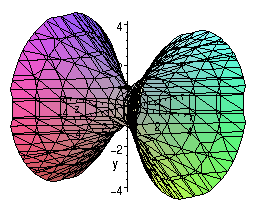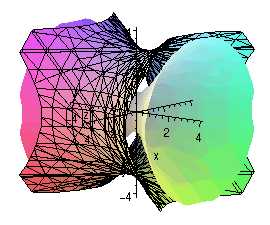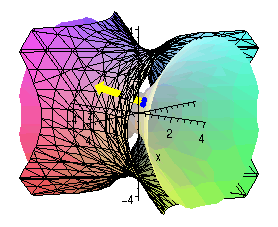gradients and level surfaces
A small exploration of the connection between the gradient vector and
level surfaces.
For a function
f, the gradient vector
grad f
has the properties that
- it points in the direction in which f increases the
fastest, and
- it is perpendicular to level curves or surfaces of
f.
A key point to note is that in the first item above the direction that
we're looking at is a direction in terms of the independent
variables of the function. Therefore, if we're considering a
function of two variables, f(x,y), the direction
is in the x-y plane. If we have a function of three
variables, f(x,y,z), the direction is in
three-space.
Example:
Suppose we have consider the function
f(x,y,z) =
x2 -
y2 +
z2.
Then grad f = < 2 x,
-2 y, 2 z >. To think about
a specific direction, let's consider the point (2,2,1).
 figure 1
figure 1: the level surface
f(
x,
y,
z) = 1
 figure 2
figure 2: the level surfaces
f(
x,
y,
z) = 9 (with grid) and
f(
x,
y,
z) = 1 (smooth).
 figure 3
figure 3: the level surfaces
f(
x,
y,
z) = 9 (with grid) and
f(
x,
y,
z) = 1 (smooth), with an
exaggerated gradient vector (yellow) shown.
At the point (2,2,1), the gradient vector is
grad f = < 4, -4, 2 >. So, to
get the largest possible increase in f, we should go in this
direction (as a unit vector, in the direction
u = (1/6) < 4, -4, 2 >). The rate
of change in f in this direction is the value of the
directional derivative,
Du f, which is
in this direction u equal to the magnitude of the gradient:
Du f = 6.
Check that all of that makes sense.
To connect this to level surfaces, note that f(2,2,1) =
1. So the point (2,2,1) is on the level surface given by
f(x,y,z) = 1, or
x2 -
y2 +
z2 = 1. What does
this look like? It's graphed in the picture to the right, and is a
double-ended trumpet bell. Notice that this makes sense: if we were
to solve this equation for z, we'd get a plus-or-minus square
root of stuff. The plus in the square root gives the top half of the
bell, and the negative the bottom.
If f is increasing, the value of the function increases, and we
get a different level surface. For example, the value 9 gives the
level surface
f(x,y,z) = 9, or
x2 -
y2 +
z2 = 9.
We can graph this as well, as is shown in the second figure to the right.
In this the first level surface is left in, but smoothed out so that
it's clear how it's related to the surface for the larger value of
f. A good way of thinking about these different surfaces is to
pretend that f represents something physical like temperature.
Then the temperature is increasing as we move from the first level
surface to the second.
Now, how is the gradient related to this? One last picture! This is
the third figure on the right, and has a(n exaggerated) gradient
vector in yellow added to the graph. Notice that the point (in blue)
(2,2,1) is located on the surface
f(x,y,z) = 1
(check that you can see that it looks like it's just about in the
right place), and that the gradient vector also looks like it points
in the right direction: < 4, -4, 2 > is in the
positive-x, negative-y and positive-z direction.
Then, is f increasing (as fast as possible) in this direction?
It certainly seems reasonable given the relative positions of the two
level surfaces. Is grad f perpendicular to the level
surface? It also looks like that's the case.
Second Example:
Find the equation of the tangent plane to the surface
x2 -
y2 +
z2 = 1 at the point
(2,2,1).
Notice that the point (2,2,1) does satisfy the equation, and so is on
the surface. To solve this, we use our work above. We know that this
surface can be thought of as the level surface of the function
f(x,y,z) =
x2 -
y2 +
z2
where f = 1. And we know that grad f
gives a vector that is perpendicular to this surface. So we can use
the gradient vector we found above as our normal vector, we have a
point already, and the equation of the tangent plane is easy:
4(x - 2) - 4(y - 2) +
2(z - 1) = 0.
gradients and level surfaces
Last modified: Mon Oct 11 18:17:29 EDT 2004
Comments to:glarose(at)umich(dot)edu
©2004 Gavin LaRose, UM Math Dept.


